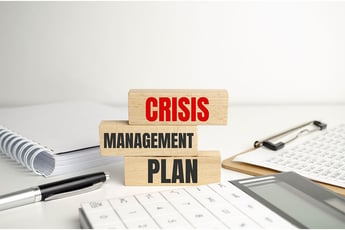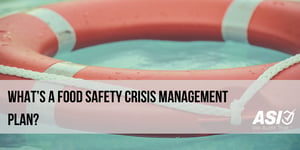Crisis management plans prescribe recommended actions to be taken because of external, environmental, climatic, equipment failure or other potential business threats that will impact the ability of the site to provide their customers with safe products. Depending on the product produced, location, etc. threats may include: Fire, Flood, Power Failure, Storm damage, Acts of terrorism, etc.

Food and beverage manufacturing facilities should be training and preparing the following resources to complete a crisis management plan:
- Risk Analysis: What are all the possible risks that may happen at your facility?
- Urgency Protocol: After understanding the risks, what is the urgency of response for each risk?
- Chain of Command and Command Center: Who is the key person for each crisis?
- Response Action: What is the decided response for each crisis? Who will need to be reached? Employees, vendors, suppliers, regulatory agencies, consumers, etc
- Internal and External Communication: How do employees communicate to each other and the world about the crisis?
Challenging Your Risks
Have you thought of all the possible risks for your organization? The obvious ones that tend to come to mind include a food safety outbreak, or a natural disaster like a fire, flood, tornado, etc.
Less obvious examples include more difficult scenarios, like what would happen if the CEO dies, or what if one employee harms another, or purposefully tampers with products to cause harm? It's not necessary to think through every terrible crisis scenario, but the more you think about these, the better prepared you will be.
What is the Urgency Level of Each Type of Crisis?
Not every crisis will need an immediate response. For instance, your facility caught fire…well, maybe it was a small fire and only one office was slightly damaged. The person who is responsible may want to send out an email to clients that sketches out the relevant details, and underscores that “while we are still assessing the damage, we may/will be up and running again within a day or so. We’ll keep you up to date.” Was there a crisis? Yes. Is it a killer to the business? No.
OK, maybe the CEO died suddenly. It’s terrible, of course. But hopefully, the CEO has a management plan that creates depth within the organization, and the interim CEO can communicate effectively the succession plan.

Who Manages Each Crisis?
After the gruesome task of thinking and writing down every possible crisis scenario you and your team can think of and the urgency of the crisis, the next obvious brainstorm is to decide who is responsible for each category of crisis. This is not just putting a name into an Excel spreadsheet and calling it good. Each person needs to take the responsibility of practicing the processes of the potential crisis consistently.
This way, when a crisis happens, the response is more like muscle memory instead of putting you and your team into fight-or-flight mode.
Loose Lips Sink Ships
Practicing communication protocols with staff may be the most important of all the tasks in your crisis management plan. Everyone needs to be on the same page, especially if media were to get involved.
Creating templates for each person and each type of crisis goes a LONG way. For instance, a template for sales to customers, buyers to suppliers, PR and/or CEO to media, etc. What you want to communicate immediately to every party with a vested interest should be planned, written, trained, and practiced.
Make these steps a priority for your facility’s crisis management plan and your business will be prepared for almost any crisis that might arise in the future.
Want to make sure your crisis plan is airtight? ASI's consultants can analyze what you have in place, or even create a plan from scratch. Email info@asifood.com for more details.

COMMENTS